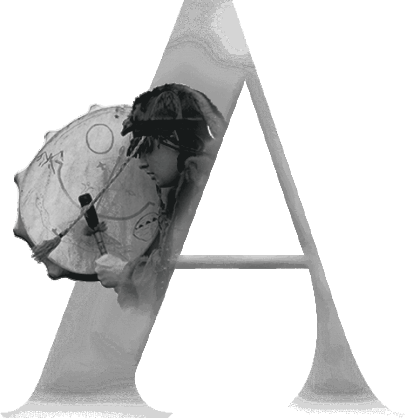The Spiritual Symbolism of Shaman Clothing: A Study of Cosmic Symbols
By the attire of shamans we can study their religious system, as the costume in which a shaman puts on means the divine presence expressed in cosmic symbols.

Different peoples have different traditions of not only the design of the ritual costume, but also of dressing in it. Altai shamans wear their costume on a shirt in winter and on a bare body in summer. The Tungusi wear their shamanic attire on their naked bodies at any time of the year. The same can be found in other peoples of the Arctic. But the peoples settling in the north-east of Siberia and the Eskimo tribes have no shamanic attire at all. In the Eskimos, for example, the shaman exposes his torso and the only clothing he wears is a belt. Most likely, such almost complete nakedness is connected with religious beliefs.
However, regardless of whether there is a shaman's outfit or not, one thing is clear: a shaman cannot perform his functions while he is dressed in everyday clothes. If there is no outfit, it is replaced by a drum, belt and hat. For example, the Shor, Black Tatars and Teleuts have no shamanic outfit, but they use a cloth to wrap around their heads. It is simply unacceptable to practice shamanism without this cloth.
The outfit is a microcosm, which differs in its qualities from the surrounding space of everyday life. On the one hand it represents a symbolic system, and on the other hand it is filled with different spiritual forces, spirits, which formed their own space in the process of initiation. A shaman transcends the mundane space and prepares to enter into contact with the spirits when he puts on his costume. This preparation becomes a direct entry into the spiritual world because the vestment is put on using numerous traditional ceremonies that precede the shamanic trance.
The very receipt, acquisition of an outfit is accompanied by certain rituals. A shaman must find out from his dreams where his future costume is. He must find it himself. In Birarchens the outfit for the price of a horse is bought from the relatives of a deceased shaman. The costume cannot leave the clan. It is related to the whole clan, which took care of the acquisition and preservation of the vestments. But much more importantly, a shaman's clothing is saturated with spirits and must not be worn by those who cannot control them. Once released, the spirits can bring harm to the entire lineage. When the outfit is worn out, it is hung on a tree in the forest so that the spirits living in it can leave it and live in a new costume.
In sedentary Tungus the shaman's outfit is kept in his house after his death. In this case, the spirits that inhabit the costume manifest themselves: it starts to shudder and move for no apparent reason. In nomadic Tungus, it is customary to place the outfit of a deceased shaman near his coffin. In some regions it is believed that the outfit may lose its power. This is determined by such signs as the death of a client during healing using a shaman's costume.
However, regardless of whether there is a shaman's outfit or not, one thing is clear: a shaman cannot perform his functions while he is dressed in everyday clothes. If there is no outfit, it is replaced by a drum, belt and hat. For example, the Shor, Black Tatars and Teleuts have no shamanic outfit, but they use a cloth to wrap around their heads. It is simply unacceptable to practice shamanism without this cloth.
The outfit is a microcosm, which differs in its qualities from the surrounding space of everyday life. On the one hand it represents a symbolic system, and on the other hand it is filled with different spiritual forces, spirits, which formed their own space in the process of initiation. A shaman transcends the mundane space and prepares to enter into contact with the spirits when he puts on his costume. This preparation becomes a direct entry into the spiritual world because the vestment is put on using numerous traditional ceremonies that precede the shamanic trance.
The very receipt, acquisition of an outfit is accompanied by certain rituals. A shaman must find out from his dreams where his future costume is. He must find it himself. In Birarchens the outfit for the price of a horse is bought from the relatives of a deceased shaman. The costume cannot leave the clan. It is related to the whole clan, which took care of the acquisition and preservation of the vestments. But much more importantly, a shaman's clothing is saturated with spirits and must not be worn by those who cannot control them. Once released, the spirits can bring harm to the entire lineage. When the outfit is worn out, it is hung on a tree in the forest so that the spirits living in it can leave it and live in a new costume.
In sedentary Tungus the shaman's outfit is kept in his house after his death. In this case, the spirits that inhabit the costume manifest themselves: it starts to shudder and move for no apparent reason. In nomadic Tungus, it is customary to place the outfit of a deceased shaman near his coffin. In some regions it is believed that the outfit may lose its power. This is determined by such signs as the death of a client during healing using a shaman's costume.
A Siberian shaman's outfit
Every Siberian shaman should have a caftan with mythical animal figures, a mask, a copper or iron breastplate, and a cap. The Samoyeds had a shawl instead of a mask, which covered the shaman's eyes and helped to get into the world of spirits through the inner light.
On the back of the caftan of Yakut shamans, among the hanging rings representing the sun, there was a drilled circle called oibon kyungete, which means "hole of the sun". However, it is generally believed to represent the Earth with a central hole through which a shaman enters the otherworld.
A crescent moon and iron chain are also placed on the back to symbolize the shaman's endurance and strength. Iron plaques are needed on the costume to protect it from the blows of evil spirits, and the fringe, which is stitched on the fur, is considered to be feathers. In general, the outfit of a Yakut shaman contains 30-40 pounds (13-18 kg) of metal jewelry. All metal objects on a shaman's outfit have their own soul and do not rust.
Metal jewelry is placed on the costume in a certain way. Along the arms, they are placed in such a way as to reproduce the arm bone. Plaques are sewn on the rib cage to represent the ribs. Above them are placed the chest, liver, heart, and other internal organs. Images of birds and animals are sewn on, a small metal emeget - the spirit of rabies - in the shape of a boat with a man is hung. The Transbaikal and northern Tungus have two kinds of costumes: one depicts a deer, the other a duck. The head of the horse resembles the carved ends of sticks. On the back hang ribbons 1 meter long and 10 cm wide. The horses are used in the shaman's travels.
On the back of the caftan of Yakut shamans, among the hanging rings representing the sun, there was a drilled circle called oibon kyungete, which means "hole of the sun". However, it is generally believed to represent the Earth with a central hole through which a shaman enters the otherworld.
A crescent moon and iron chain are also placed on the back to symbolize the shaman's endurance and strength. Iron plaques are needed on the costume to protect it from the blows of evil spirits, and the fringe, which is stitched on the fur, is considered to be feathers. In general, the outfit of a Yakut shaman contains 30-40 pounds (13-18 kg) of metal jewelry. All metal objects on a shaman's outfit have their own soul and do not rust.
Metal jewelry is placed on the costume in a certain way. Along the arms, they are placed in such a way as to reproduce the arm bone. Plaques are sewn on the rib cage to represent the ribs. Above them are placed the chest, liver, heart, and other internal organs. Images of birds and animals are sewn on, a small metal emeget - the spirit of rabies - in the shape of a boat with a man is hung. The Transbaikal and northern Tungus have two kinds of costumes: one depicts a deer, the other a duck. The head of the horse resembles the carved ends of sticks. On the back hang ribbons 1 meter long and 10 cm wide. The horses are used in the shaman's travels.
An Altai shaman's costume
A caftan of an Altai shaman is made of deer or goat skin. It is sewn with many scarves and ribbons that symbolize snakes. Some ribbons have the shape of a snake's head with an open mouth and eyes. Large snakes have a split tail, and sometimes it is found that three snakes have only one head.
There are also several iron objects on a caftan. Among them is a small bow with arrows, designed to scare away spirits. Two copper circles and animal skins are sewn on the back of the costume. The collar is decorated with a fringe of brown and black owl feathers. There are also seven figures with brown owl feathers instead of heads. They symbolize the seven heavenly maidens. The seven bells that adorn the costume are considered to be the voices of these maidens. In some regions, there are nine heavenly maidens. They are believed to be the daughters of Ulgen.
The shaman's costume, as well as everything associated with shamanism, is endowed with power, which is retained after the death of its owner. Therefore, most peoples do not keep a shaman's costume, but leave it in the burial of a deceased shaman. The ritual outfit is thought out to the smallest detail, because in spiritual journeys a shaman needs protection and help, which is given to him by symbolic images of helping spirits.
There are also several iron objects on a caftan. Among them is a small bow with arrows, designed to scare away spirits. Two copper circles and animal skins are sewn on the back of the costume. The collar is decorated with a fringe of brown and black owl feathers. There are also seven figures with brown owl feathers instead of heads. They symbolize the seven heavenly maidens. The seven bells that adorn the costume are considered to be the voices of these maidens. In some regions, there are nine heavenly maidens. They are believed to be the daughters of Ulgen.
The shaman's costume, as well as everything associated with shamanism, is endowed with power, which is retained after the death of its owner. Therefore, most peoples do not keep a shaman's costume, but leave it in the burial of a deceased shaman. The ritual outfit is thought out to the smallest detail, because in spiritual journeys a shaman needs protection and help, which is given to him by symbolic images of helping spirits.
+79221343011 Whatsapp, Viber, Telegram, Signal
info@ahamkara.org
Follow Ahamkara on:
https://ahamkara.teachable.com/ - Online Shamanic School
https://www.facebook.com/ahamkara.eu/notifications... - my Facebook
https://www.instagram.com/ahamkara.eu/ - my Instagram
https://t.me/ahamkara_training - telegram channel
info@ahamkara.org
Follow Ahamkara on:
https://ahamkara.teachable.com/ - Online Shamanic School
https://www.facebook.com/ahamkara.eu/notifications... - my Facebook
https://www.instagram.com/ahamkara.eu/ - my Instagram
https://t.me/ahamkara_training - telegram channel
